Genealogy

This chart, as do all genealogy charts, shows genetic lines of descent. It differs from conventional charts in its attempt to indicate relationships between entire races, as well as individuals.
In order to reduce complexity in the graphic, the actual personages responsible for the creation of particular races are not indicated, though the individuals themselves do appear on the chart. That information, where available in Parks’ recollections, is provided in the Races section.
Relative positioning on this chart is not very meaningful. However, genetic descent does run from higher to lower down the lines.
In the vastness of time, entire species have migrated from one star system to another. This is specifically the case with the Kingú-Babbar, who relocated from Ušu (Draco), where they created the Ušumgal, to Urbar’ra (Lyra), and later some went to Te (Aquila). In the genealogy chart above (which is under development), locations associated with root sources or with newly-created species refer to dwelling places at the time the creation took place. Thus the Kingú-Babbar are shown associated with Ušu. In other words, the graphic is not a snapshot of any given point in time.
The Gina’abul have a concept of father and mother. However, very little impregnation took place. In fact, this was banned by law. Sa’am was created by his "father" An in the laboratory. Although it was clear that An contributed some of his own genetic material to his creation, it is also clear that there was something else, and what that was, was a subject of intense interest and discovery throughout the book.
As illustrated in the chart above, Sa’am actually incorporates genetic material from his eventual lover Mamitu-Nammu, herself partly amphibian through her Abgal heritage (see Races).
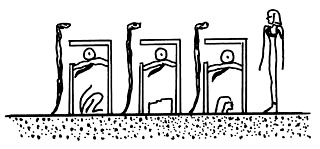
Figure from the Egyptian funerary text of the Amduat, in the tomb of Thutmosis III (18th dynasty), 6th hour, register 1, scene 5. A priestess named "The Worshipper of God" attends three artificial wombs in which bodies assemble themselves according to "images." On the upper part of each of the wombs appears an ovum fertilized by a spermatozoon.
The text states:
"The flesh is jubilant and rejoices. The head speaks after having reassembled its members.""These are the secret images of the Duat."
"Those who are on their belly (reptiles) protect them."
"When Râ (the light) illuminates their darkness, the head speaks after the Worshipper of God calls it."
Personages
| Abzu-Abba | Ušumgal. The elder, "father" of the Gina’abul, progeny of the royal root source of Urbar’ra (Lyra) (see Worlds), master and absolute lawgiver of the interior (Abzu) of Nalulkára and Abzus of all Gina’abul planets. Within the first days of his life, Sa’am pays a visit to Abzu-Abba, kills him, and inherits his lands. |
| An | "Seventh of the Ušumgal," creator of Sa’am and of the Anunna, of which he is the supreme chieftain. |
| Anšár | Ušumgal. Male. One of the creators (the father) of An. |
| Kišár | Ušumgal. Androgyne brother/sister of Anšár and mother of An. |
| Lahamu | Ušumgal. Progeny of the royal root source of Urbar’ra (Lyra). Androgyne progeny of Abzu-Abba. Co-creator of Anšár with Lahmu. |
| Lahmu | Ušumgal. Progeny of the royal root source of Urbar’ra (Lyra). Male progeny of Abzu-Abba. Genetic homologue of Lahamu, differing only in sex. |
| Mamitu-Nammu | Amphibian (more fish than reptile), created by Tiamata partly from her own genes and genetic material from Gagsisá (Sirius). "Mother Tutor" of the Kadištu on Uraš (Earth). With Sa’am, co-created the Nungal. |
| Ninmah | Grand Priestess of Nalulkára. Right arm of Tiamata. With An, co-created the Anunna. |
| Sa’am | "The good lord, the well fashioned." Amphibian, cloned genderless by An; later given male sex by mother/lover Mamitu-Nammu. Also named Nudimmud. |
| Tiamata | Ušumgal. Queen of the Gina’abul of Margíd-da (see Worlds). Named Tigeme by the male Gina’abul of Margíd-da. Mother of Lahamu and Lahmu. |
Abzu
It is necessary to come to terms with the idea of the Abzu, a prominent feature of Mesopotamian belief systems, before going on to consider the Gina’abul worlds, because every planet and moon in Parks’ history has one.
To the Sumerians, the Abzu, realm of Enki, was a subterranean sea or swamp – a sort of sandwich layer, as the Sumerians didn’t have a concept of a spherical Earth. Zecharia Sitchin frequently translates Abzu simply as Africa. However, in the experience of Parks/Sa’am, the Abzu was the hollow center of each world, fully inhabited and thriving with life, even urbanized. We have all encountered the idea: openings at the poles, oceans connecting with the interior over a gently-curved broad rim, and a sun at the center.
In other words, the Abzu is a structure that contradicts our common knowledge of the Earth and all other planetary bodies in the Solar System – and seems to violate our understanding of physics as well.
This little problem challenges our ability to accept Parks’ report. It is not as though one could say, "I’ll consider the rest but hold the Abzu, please," because activities and events taking place in the various Abzus of Parks’ cosmos are so thoroughly a part of the narrative that it would be akin to saying "I can accept your description of human physiology but I just can’t go with the alimentary canal."
Parks has spent much effort on this problem. In collaboration with Hans W. Lintz, Parks provides an extensive report in the Dossier: Les Mondes Creux. We have reviewed the portions of the report relating to the Earth and Moon (i.e., not dealing with data on other solar system planets). Briefly, we find one highly interesting nineteenth-century personal account of a fisherman and his father who sailed into the northern opening, spent 1-1/2 years with the civilization in the cavity, sailed out the southern end, and were shipwrecked there. Beyond that, the well-known and controversial story of Admiral Byrd’s adventures and dubious satellite data add little to the case for the Abzu. Yet we could not have expected more in the way of data in the public domain at this time.
Meanwhile, we can touch on some basic questions.
The first – and naive – concern would be about how gravity would work in this situation. How could you run a city in there, with people falling to the center of the Earth all the time? Doesn’t gravity "point" to the center of the Earth?
The answer is: yes if you are on the surface, and yes if you are above the surface; no if you are deep into the interior and especially no if you are at an inner surface of a hollow Earth. In that case, gravity points away from the center. (The larger the cavity, the more this is true. If you were in a small room carved out of the interior of the planet, you would experience weightlessness.)
Now that is certainly convenient but how is it possible?
Recall that the gravitational force between two masses is inversely proportional to the square of the distance that separates them. When we stand on the Earth’s surface, the net force is certainly toward the Earth’s center, but on a particle-by-particle basis, most of that force is due to a part of the Earth’s mass that is fairly close (in terms of the Earth’s size) to where we are standing. The rest is simply too far away to contribute very much.
If we are in space, much farther out than the diameter of the Earth, then all of the Earth’s mass goes into the equation to the same extent.
If we are at an inner surface of a hollow Earth, the closest mass is between us and the outer surface on the side where we are. The other side of the hollow Earth is again too far away to contribute much to the equation .
And so we have a workable gravitational system.
Now about that sun that always seems to be present at the center: WHY, where did it come from, and what makes it stable in that position?
Part of the problem is in failing to grasp the sun and the surrounding planet as a single unit, and to think about the process of planetary formation. Open SETI frequently entertains the cosmological and physical theories of Dr. Paul A. LaViolette. In particular, as described in Open SETI Physics 101, planets are formed from the energy and particles emitted from a gravitational well where there is excess genic energy. At the point of emission, there is probably what appears to be a hot little sun.
The next phase might be an interaction between interstellar particles being attracted toward the gravitational well, and outward-moving energy and particles. Might there be a point of equilibrium at a given radius where a shell of matter would begin to form? The details of this process are not to my knowledge given in any of LaViolette’s books (if they are, we will find out shortly).
What is the mechanism that stabilizes the system so that the sun does not wander around and collide with the shell? Again on our page, we mention that the genic energy radiation pressure goes as 1/r4, which creates a strong restoring force opposing any such tendency.
Another major detail requiring an explanation would be the holes at the poles of rotation. I personally am not clear on this point, as the dynamics appears complex, but it seems reasonable that if there was rotation in the first place, that these holes might appear due to centrifugal force.
The reader will surely ask, "How can it be that all planetary bodies are hollow with openings at their poles, and we have not seen this in the images from our interplanetary probes?"
The unspoken question: "Are we to believe that the data have been withheld from us, and if so, why? Why go to all that trouble? What is the point?"
Parks’ logic in response is perfect. However, whether you can accept it depends on just how far you are willing to go with the idea that we are living in a manipulated, make-believe world. Parks’ reasoning is as follows:
To confirm that all planets are hollow would be to admit that the Earth is equally so. To recognize that this planet is hollow, with a habitable interior, implies that one must make an accounting of possible other populations, and undertake expeditions to the center, but that is at the moment completely impossible. Why? Because, according to numerous legends of the Earth and in accord with the traditions of Tibet, the Eskimos, and even the Hopi Indians of Arizona, the interior of the Earth is occupied by a civilization of a highly developed intelligence, affiliated -- for some of them directly, and for others indirectly -- with the "Celestial Bestiary!"
Most of our readers have heard of these legends. For many of us, our response has had to be to afford them a measured level of credibility, as though to say we respect those peoples who hold these myths and say these things, but not to face the implications. The reason is that the complete break from the common worldview that would be required, the end of the SCAM, seems to present an imposing prospect, if not absolutely frightening.
But for others, it’s a way of life.
Worlds
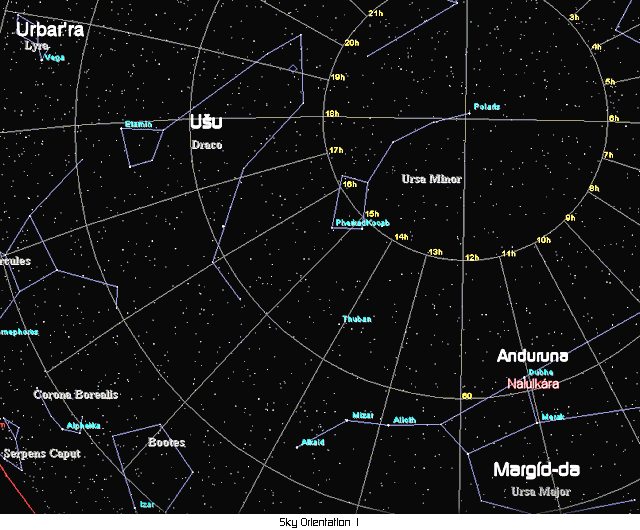
Constellations as we define them are not experienced by the Gina’abul. Anton Parks, tapping into Sa’am’s memory, recalls awareness of "mother stars" (i.e., stars with life on one or more of their planets) and various groupings of stars before his arrival in our solar system. Once on the Earth, he could easily recognize the mother stars within the constellations as seen from here.
The star group known in the Emenita language as Margíd-da (see above image), which we can loosely associate with our defined constellation Ursa Major (the Great Bear), is the home of the Gina’abul. The giant planet they call Nalulkára is their imperial residence, "at the heart of Anduruna," a stellar system identified with the star Dubhe.
Also known as alpha Ursae Majoris, Dubhe is a yellow giant, about 25 times the size of the Sun, and located 86 light years from here. Dubhe is a "close visual binary."
The Uanna, monumental mothership of the Gina’abul lord An, is reported by Parks to have been – at the opening of his narrative – situated on the "night side" of Nalulkára. This implies a synchronized rotation or "resonance" of Nalulkára with respect to Andaruna/Dubhe, similar to that of our moon with the Earth.
 Parks mentions a short night on Nalulkára due to a second nearby star. In fact,
Dubhe B is catalogued. At present, a
projected distance of 23-25 AU from Dubhe (based on angular separation) has been published. That would correspond to the distance of Uranus from the Sun. I don’t believe the actual position of Dubhe B with respect to Dubhe is known. The graphic at right is shown from an arbitrary viewing position and is purely suggestive.
Parks mentions a short night on Nalulkára due to a second nearby star. In fact,
Dubhe B is catalogued. At present, a
projected distance of 23-25 AU from Dubhe (based on angular separation) has been published. That would correspond to the distance of Uranus from the Sun. I don’t believe the actual position of Dubhe B with respect to Dubhe is known. The graphic at right is shown from an arbitrary viewing position and is purely suggestive.
As of this writing, March 9, 2006, no planet corresponding to Parks’ giant Nalulkára has been detected.
Parks also "saw" (as Sa’am, in his initial flight made on the first day of his life!) entire cities of thousands of Amašutum near the "southern" extremity of Nalulkára.
The royal city of Nalulkára is named Unulahgal.
The city of Ankida was where the complete genetic patrimony (as frozen cells) of the Ušumgal was stored.
Beyond the Amašutum cities is the opening into the "Abzu of Nalulkára," named for the old father/king Abzu-Abba. Not the most beautiful in the Anduruna system, but the most vast of all the planets possessed by the Gina’abul, and those on which they had set foot up to that time.
Also seen in Sky Orientation 1 is Ušu (corresponding to our Draco), the "birthplace of the Gina’abul"
Urbar’ra (Lyra) is the birthplace of the Miminu (Greys), who were created there by the ancestors of the Ušumgal (see Races) with the assistance of the Mušgir, who contributed their genetic patrimony.
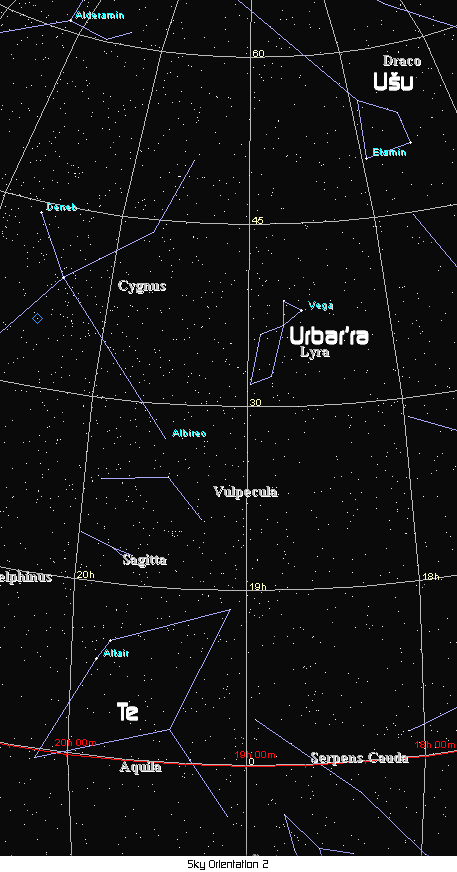
Sky Orientation 2 again shows Ušu and Urbar’ra in the northern sky, and also includes
Te (Aquila), home of the Kingú, near the celestial equator.
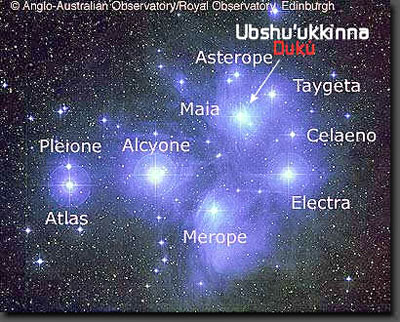
(Click image for 3D closeup)
The very important planet Duků is the place where the Anunna were created. (We will have much more to say about that activity.) Duků is in the system of Ubšu’ukkinna (Maia), one of the bright blue-white stars in the group known to the Gina’abul as Mulmul (the Pleiades star cluster).
According to Parks’ memory, the Ubšu’ukkinna system has 12 planets.
See Decoder for a decomposition of the name Ubšu’ukkinna. This was also the name of the sacred place of assembly in each large Mesopotamian city.
The Hopi indians of Arizona call the celestial Ubšu’ukkinna Toonaotakha, which they translate as "the Confederation of Planets." It refers to a celestial region of 12 planets where dwell the Kachinas, the spiritual guides of the Hopi traditions (see Joseph Blumrich’s transcription of White Bear’s teachings, KASSKARA UND DIE SIEBEN WELTEN). The Toonaotakha stellar system is precisely situated in the Pleiades, named by the Hopis "Seven Sisters."Blumrich’s work with White Bear is covered extensively by Anton Parks on Parks’ page ATLANTIS CONTRE MU, found on Anton Parks.com. Kásskara is identified with the ancient Mu; Talawaitichqua with Atlantis.It’s interesting to note that the term Toonaotakha is formed from the Hopi root Toonao which means "belongs to a group," and is itself taken from the term Toonam, "group" or "tribal council." Once again, all fits perfectly.
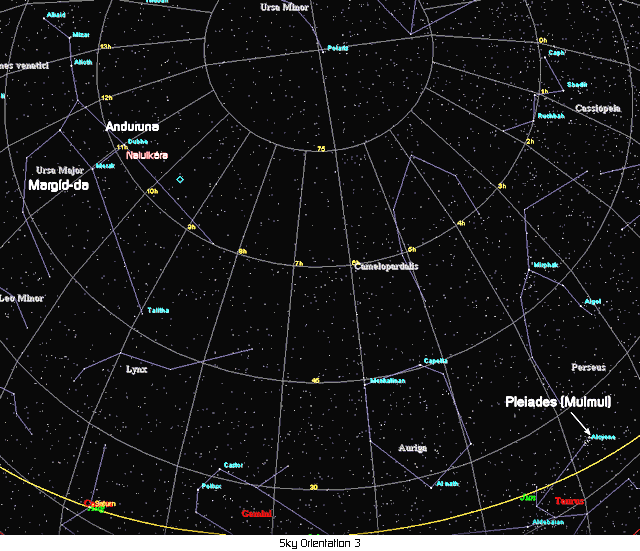
Sky Orientation 3 above, shows the location of the Pleiades in Taurus.
Farther south in Sky Orientation 4 below, Gagsisá (Sirius) is the source of the (amphibian) genetic material used by Tiamata in the creation of Mamitu-Nammu... and through her, inherited by Sa’am. Both Mamitu-Nammu and Sa’am have slightly webbed hands.
All of this will be found to be important with respect to Dogon legends.
Gagsisá is considered to be one of the most important bases of the Life Designers confederation, an "admirable place."
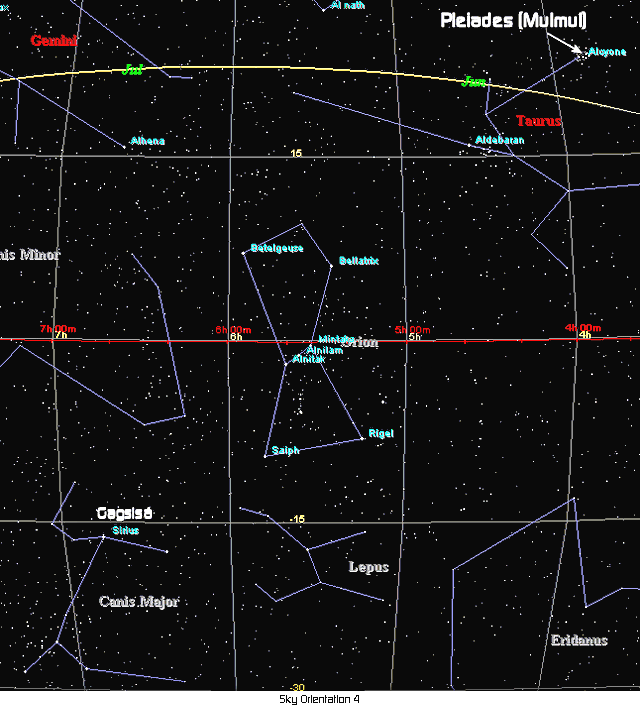
The following graphic helps to visualize the important Gina’abul locations in three-dimensional reference to our solar system (Tiamate). It is based on a map of the brightest stars in the solar neighborhood out to 50 light years. Where Parks names specific stars that fall within this radius, these are circled and labelled. Where only constellations are identified, any stars on the map that belong to those constellations are indicated.
Some constellations extend beyond the boundary of the map, and one (Ubšu-ukinna) lies far beyond the border, at 440 l.y. Anduruna, while it appears in the Ursa Major constellation (which is largely included in the map), is actually not part of it, and lies 124 l.y. from here.

Situated at the intersection of numerous galactic routes, Tiamate (the solar system) was named by the Kadištu in homage to the Gina’abul queen Tiamata, who had done so much for peace and for this celestial region.
In Gina’abul, Ti-ama-te evokes "the place where compassion and life intersect" because there existed here an experimental sphere in which innumerable forms of life cohabited. This was Uraš (the Earth), the major center of the Gina’abul universe.
Uraš (the Earth) is a place of duality where the notions of good and evil are experimented on with vehemence. This carries no judgment.Before the Gina’abul and Anunna took the Earth totally in hand, Uraš was a zoological garden or park in which the Kadištu had placed the ensemble of their knowledge; this explains why there was such diversity. The frequency of the KI (3rd dimension) on Uraš was much higher before all the reptilian wars.
As Marciniak says it so well, the Earth is a living library. Our solar system is at the crossroads of important routes that the Life Designers have borrowed since the night of time.
Stargates
The important Gina’abul centers known to Parks are scattered over distances of several hundred light years. One wonders how the Gina’abul manages such a far-flung society, and whether distance itself has any importance to them.
In their endless wars, is the proximity of star systems a factor? Consider our experience here on this planet, in which "spheres of influence" lost their geometric meaning once we mastered the art of high-speed intercontinental travel.
The Gina’abul have apparently done this on their scale, but how did they do it?
According to Parks, stargates -- the Gina’abul word is Diranna -- are the key.
These famous ports have always been primary for beings mastering the techniques of space travel. Each planet possesses very numerous Diranna. As for the Gina’abul, it was more or less customary to construct our larger centers where the Diranna were more densely clustered.To be more precise about their function, I must make it clear that the Diranna are ports leading [through tunnels] toward vortices where the notion of time does not exist, where time literally collapses upon itself by the concentrated action of particles of light, because an excessive concentration of light inhibits time. These tunnels are formed of particles moving at such a speed that the notion of time there is nullified.
The timeless vortices are countless, innumerable. On the anatomical scale, one can grossly compare them to various blood vessels serving to irrigate the living body. On the scale of spatial geometry, they function in the same way where all the planets are linked together, each stellar system being itself in liaison with its neighbors, each island universe (galaxy) equally linked and so forth....
In fact, the timeless vortices permit anyone in this universe to travel to a point in another more quickly than light. The tunnels, invisible to the human eye, are like bridges thrown between the worlds and the galaxies. They vibrate on extremely short wavelengths, like nothing that we know in our three-dimensional world, other than the wavelengths that we can observe in the infinitely small.
Light is corpuscular -- that is, it is made up of tiny particles. The timeless tunnels are composed exclusively of particles of the type known as tachyons that are superluminally connected to one another and that propagate light very quickly. Tachyons create fields of subtle energies and make up the missing mass of the universe that evades today’s specialists....
It is remarkable that the ancient Egyptians used exactly the same vocalization to express the words door and star. This term is Seba. Its Gina’abul-Sumerian decomposition [see Decoder] indicates the reason: its syllables mean "brightness that opens" and "that which gives (allocates) light". Ancient Egyptian dwellings were constructed without windows in order to keep the high heat from penetrating the interiors. The only opening that brought in the light was indeed the port of entry.
Other definitions are also possible thanks to Sumerian homophones: SE-BŔ = "the light of life" and SE-BA7, meaning "the light of the soul" or "that which distributes light". These Gina’abul-Sumerian definitions afford a better understanding of why the Egyptian Seba does not apply solely to the semantic of a door or a star, but equally to instruction and apprenticeship. We all know that light is synonymous with consciousness, wisdom.
Souls
In the Karmapolis interview, Alain Gossens asked Parks to speak about the souls who incarnated on the Earth at the time of the Gina’abul colonization, and to explain the purpose of the Gina’abul in this.
With the arrival of the Gina’abul, this place has become a zone of free "judgment." Many consider that it is a stroke of fortune to be able to incarnate on the Earth today because the instruction here is intensive and altogether unaccustomed.Parks also mentions that the Gina’abul are incarnating beings, just as we are, and that certain humans can easily incarnate among them, and they among us. There are no particular rules about this, other than the evolution of species through karmic laws, which most of the Gina’abul males still have not absorbed.That which would require several thousand earth-years to learn elsewhere in our galaxy takes two or three lives here, on the Earth!
Now the situation is going to change and the reign of the Gina’abul is soon going to be finished. This is part of the order of affairs and the souls who incarnated on the Earth for several thousand years and who still haven’t finished their education know it very well. This explains, I think, the fact that more and more souls incarnate on the Earth. They wish to profit from this situation right up to the end.
The Gina’abul permit this order of affairs by their past and present actions (cleverly hidden). They truncated the genetic code of human beings to transform them into Á-DAM (animals, see Decoder) at their service. This remains the actual situation today, above all seen when one dispassionately distinguishes the aberrant and often inhuman behaviors of the rulers of this world at the service of the galactic gravediggers that the Kadištu call Gilimanna (Celestial Bestiary).
The souls who incarnate on the Earth know where they put their feet! The fact that the greater part of the Gina’abul became galactic outlaws and in conflict with the Life Designer community of our universe is not incompatible with the karmic work executed here. All is but a story of appreciation. The soul who will have experienced negation under all its forms on the Earth will render justice to itself when it returns "on high". It will finish by testing the universal allegation in putting itself at the service of its neighbor and then of the Source from which it issued and toward which it returns by all ways. The tortuous and circuitous roads that it took to attain this goal and which engender different forms of suffering are known only to it.
Divinities
From the Karmapolis interview (slightly edited):
In the Gnostic cosmology, Sophia is an Aeon, a cosmic divinity, who was part of an ensemble known as the divinities of the Pleroma.1Parks traces the evolution of concepts of the "Mother Goddess" and masculine deities in the literature of human societies. We quote here (with a little editing) from his Note 22, pp. 118-119, Le Secret.We readily identify these galactic divinities who work in the light with the Kadištu (life designers) – the same Kadištu whom one also identifies as the Elohim of the Bible.
[Use the Decoder to demonstrate this connection.2]
Elohim is the Hebrew term used in antiquity to designate the original creator divinities of the Earth and of the original human being of Genesis – Adam not appearing until the "second creation" (Gen. 2.7) by the intention of Yahweh who is a blend of the Sumerian "gods" An, Enlil, and Enki.
Who among the Kadištu were closely related to the patriarchal order named Yahweh? There were two principal entities: Tiamata and her daughter Nammu: Sophia and her daughter Zoe to the Gnostics.
- An exemplary pagan Gnostic depiction of this kind is the subject of John Lash’s extensive Metahistory Quest website. We treat with Lash’s Gnosticism on the Open SETI page Gnosticism, Archons/Greys, The Controller Agenda. A study of parallels and differences between Lash’s and Parks’ Gnostic views would be a worthy project.
Compare the meaning in Emeša of the syllables in the Akkadian word Qadištu, with the meaning in Emeša of the syllables in the Sumero-Akkadian phonemes corresponding to the Hebrew word Elohim. The match is close to perfect and the difference reveals the spin, does it not?
In diverse passages of the Judaic literature but also of the Bible and other traditions of the planet, "the original primordial and androgyne source" has been subtly replaced by a masculine divinity named God or The Father.It is clearly seen that at the epoch when the scripture made its appearance on the Earth and the cosmogony of the biblical texts was drafted (in fact, several thousand years later, after 1000 B.C.E.), the religion of the Mother-Goddess was losing ground; in reality it has not ceased to regress over the course of time.
The growing acceptance of the male religions by numerous patriarchal societies rapidly accelerated the extinction of the feminine creator divinity. Under these conditions, the monotheistic drafters could not attribute the full original creation to any entity other than God himself -- a masculine entity -- while they clearly knew that the first creation was rather the work of plural entities (the Elohim) at the service of a Mother Goddess, a jointly-conceived master plan for the Earth. Everything pertaining to this ancient Mother Goddess divinity was grossly deformed, demonized, or radically suppressed. The patriarchal doctrine that consisted in marking the domination of God over an ancient feminine divinity, totally submitted to its orders, therefore took over.
In the mythology of India, the Divine and primordial Energy is called Shakti, which transposed into Sumerian gives ŠA6-AK-TI, literally "the good miracle-worker of life" [See Decoder ].
Shakti is no other than the representation of the Divine Mother, the Mother-Goddess, more precisely the personification of the feminine principle that Hinduism very correctly associates with the Holy Spirit. This obliges us to [examine] the Hebrew Ruah Elohim, which means spirit of God, the Holy Spirit. [See Decoder for the decomposition of the feminine Ruah].
The Mother-Goddess, skillfully demonized by the dominant patriarchy of the Judaic religion, is concealed in the demonness Lilith. Some associate Lilith with the Hebrew lailah -- night. Others think that Lilith comes from the Sumerian term LÍL-TI, generally translated as "spirit of life," but I would rather interpret it, in our context, as "she who gives the breath of life," in the sense of "the entity who breathed life into the primordial man."
Judaic imagery represents Lilith as a night bird, a symbol taken directly from one of the most ancient attributes of the Mother-Goddess, that is to say the bird or the dove that the Christians used to symbolize the Holy Spirit. This volatile aspect of Mother-Goddess is also found in Greek mythology, where Eurynome, the universal and primordial goddess, changes into a dove while pondering the universal egg from which all things come.
An amusing note: if one translates the name of the primordial goddess from Greek into Sumerian, one gets ERIN2-UM (no "O" in Sumerian): bands of midwives (or old or even ancient women), or again ERIN2-UM-ME: bands of midwives of divine order.
The same idea is found in the Egyptian traditions, throughout the pyramid texts, which relate that the supreme and androgynous divinity Atum (from his Egyptian name Itemu) metamorphoses into the bird Ben to create the air, the Earth, and the sky (or heaven). Thanks again to Emeša, the matrix language of the priestesses that incorporates the Sumero-Assyro-Babylonian particles, we are going to obtain some confirmations and to clarify this a bit more.
First, we translate the name of this divinity into IT-EM-U, "the meterological force," which clearly attests to its creative function cited above (creation of the air, the Earth, and the sky). Next, its Greek name Atum, which gives AT-UM "the old father-woman," confirming the androgyny of Atum or at least the fact that this entity symbolizes different creative forces at the service of the same cause. And finally, the term Ben that is attributed to this bird-phoenix creator and that gives BÉ-EN, "the lord who speaks." Numerous traditions assimilate the word to the creation of the world.